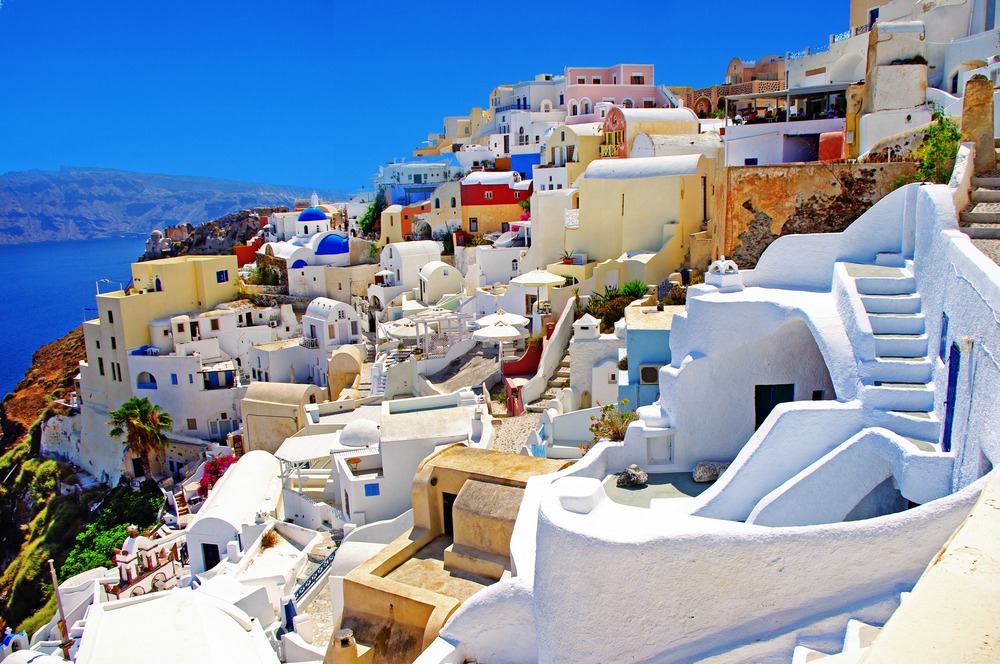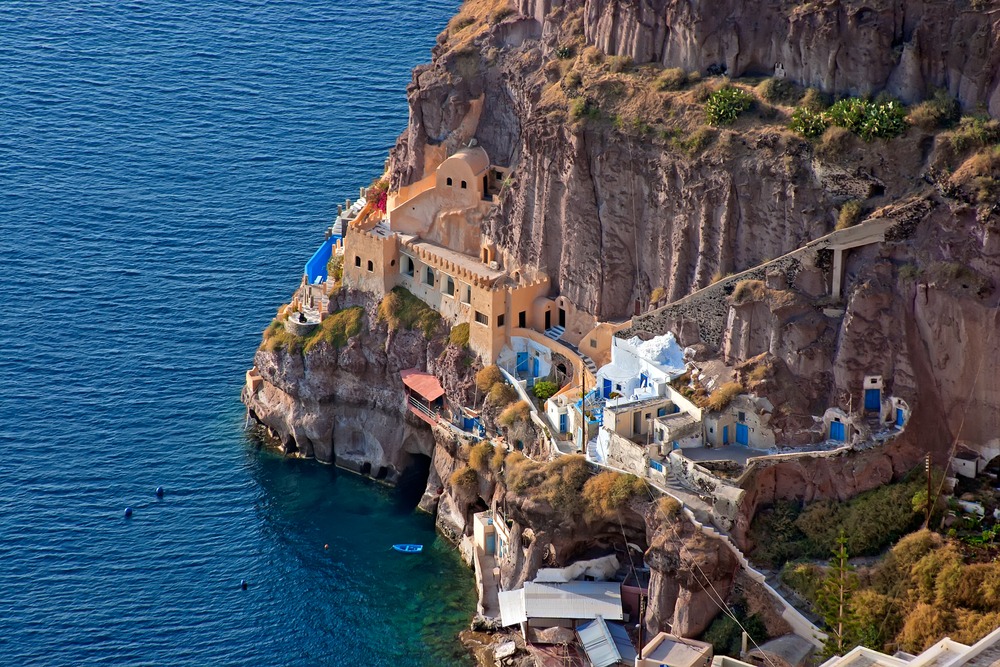Santorini, Greece: A Timeless Gem of the Aegean

A DETAILED HISTORY OF SANTORINI
Ancient Origins and Prehistoric Glory
Santorini, known in antiquity as Thera, is part of the Cyclades island group in the Aegean Sea. Its earliest settlements date back to the Neolithic period (around 4th millennium BCE), but the island’s most significant ancient history began with the flourishing of the Minoan civilization. Around 2000 BCE, a vibrant Bronze Age society emerged, centered around the city of Akrotiri, which became a prosperous port city engaged in trade with Crete, Egypt, and mainland Greece.
The Minoan Eruption and the Legend of Atlantis
Around 1600 BCE, Santorini experienced one of the most catastrophic volcanic eruptions in recorded history—known as the Minoan eruption. This massive explosion decimated the island’s population, buried Akrotiri in volcanic ash, and created the island’s iconic caldera. It also triggered tsunamis that impacted Crete and other parts of the Aegean, contributing to the decline of the Minoan civilization. The scale and suddenness of the disaster may have inspired the legend of Atlantis, as described by Plato.
Dorian and Hellenistic Periods
After centuries of desolation, the island was resettled by the Dorians in the 9th century BCE. They established the city of Ancient Thera on Mesa Vouno, which flourished through the Archaic, Classical, and Hellenistic periods. The city featured temples, marketplaces, baths, and a strong military culture. Santorini maintained regional significance through alliances and trade, often aligning with powerful Greek city-states.
Roman and Byzantine Eras
Under Roman rule, Santorini remained an important naval and trading hub. Christianity arrived in the early Byzantine era, and the island saw the construction of early Christian basilicas. However, it faced frequent pirate raids and natural calamities that diminished its prominence during the medieval period.
Venetian and Ottoman Rule
From the 13th to 16th centuries, Santorini was governed by Venetian noble families and renamed “Santorini” after Saint Irene (Santa Irini). They fortified the island with castles and introduced Catholicism alongside Orthodox Christianity. In the 16th century, Santorini fell under Ottoman rule, leading to relative autonomy but economic hardship. The island survived piracy and limited foreign influence during this time.
Modern Era and Tourism Renaissance
Santorini became part of the modern Greek state in 1830. The island’s economy historically revolved around wine production (especially the sweet Vinsanto), tomato canning, and trade. In 1956, a powerful earthquake devastated much of the island’s architecture, prompting significant rebuilding. In the late 20th century, tourism began transforming the island. Today, Santorini is world-renowned for its whitewashed villages, dramatic cliffs, sunset vistas, luxury resorts, and archaeological treasures, drawing millions of visitors annually.

TOP 25 ATTRACTIONS IN SANTORINI
1. Oia Village
Perched on the northern tip of the island, Oia is Santorini’s crown jewel. Its blue-domed churches, cave houses, and breathtaking sunset views over the caldera make it one of the most photographed spots in the world.
2. Fira (Thira)
The island’s bustling capital is a lively blend of shops, restaurants, and cliffside hotels. Overlooking the caldera, Fira is home to museums, churches, and vibrant nightlife while offering panoramic views of the Aegean Sea.
3. Akrotiri Archaeological Site
Often dubbed the “Pompeii of the Aegean,” this ancient Minoan city was buried in volcanic ash around 1600 BCE. Visitors can walk on elevated platforms through preserved streets, homes, and frescoes of a sophisticated prehistoric civilization.
4. Ancient Thera
Located on Mesa Vouno mountain, the ruins of Ancient Thera date back to the 9th century BCE. Explore remnants of temples, a theater, and Hellenistic architecture while enjoying sweeping views over the Kamari and Perissa beaches.
5. Red Beach
Near Akrotiri, this unique beach is famous for its towering red volcanic cliffs and strikingly colored sand. It’s a favorite for sunbathers and photographers alike.
6. Caldera Clifftop Walk (Fira to Oia)
This scenic 10 km trail offers one of the most stunning hikes in Europe. Winding through Fira, Firostefani, Imerovigli, and finally Oia, the walk passes whitewashed chapels, cliffs, and panoramic seascapes.
7. Santo Wines Winery
Santorini is known for its Assyrtiko grape, and Santo Wines offers tours, tastings, and views over the caldera. Enjoy wine flights paired with local delicacies as the sun dips into the sea.
8. Amoudi Bay
A charming harbor beneath Oia, Amoudi Bay is known for its seafood tavernas, crystal-clear swimming spots, and traditional fishing boats. The walk down the 300 steps from Oia is steep, but the experience is unforgettable.
9. Pyrgos Village
This hilltop village was once the capital of the island. Its Venetian castle ruins, traditional Cycladic homes, and panoramic views make Pyrgos a peaceful yet scenic escape from the tourist-heavy coast.
10. Imerovigli
Often called the “balcony to the Aegean,” Imerovigli is a quiet village with luxurious cliffside accommodations and romantic dining. It’s also home to Skaros Rock, a volcanic outcrop with hiking paths and ruins.
11. Skaros Rock
This natural rock formation was once a medieval fortress and capital. Today, visitors hike to its summit for panoramic caldera views and to explore the remains of stone walls and churches.
12. Firostefani
A picturesque village between Fira and Imerovigli, Firostefani is ideal for sunset views and quiet strolls along cobbled paths with panoramic views of the volcano.
13. Museum of Prehistoric Thera
Located in Fira, this museum houses remarkable artifacts from the Akrotiri excavation, including frescoes, pottery, tools, and one of the world’s oldest preserved murals—“The Blue Monkeys.”
14. Megalochori Village
This peaceful inland village offers an authentic taste of Santorini’s culture. Stroll its quiet lanes, see traditional bell towers, and stop at boutique wineries like Gavalas or Boutari.
15. Black Sand Beaches – Kamari and Perissa
These popular beach resorts are known for their dark volcanic sands, water sports, and vibrant seaside bars. Kamari also has a charming promenade ideal for evening walks.
16. Akrotiri Lighthouse
At the southwestern tip of the island, the Akrotiri Lighthouse is a quiet spot for panoramic views of the caldera and sunset away from the crowds.
17. Prophet Elias Monastery
Situated at Santorini’s highest point (567 meters above sea level), this 18th-century monastery offers unparalleled views and insight into Greek Orthodox traditions.
18. Art Space Winery and Gallery
Located in an old wine cave in Exo Gonia, this space combines a wine cellar with a contemporary art gallery. The tunnels, carved into volcanic stone, offer a unique ambiance.
19. Wine Museum Koutsoyannopoulos
This underground museum tells the story of winemaking on the island from the 1600s to today. Visitors can explore exhibits, tools, and taste family-produced wines.
20. Cathedral of Saint John the Baptist (Catholic Cathedral)
Located in Fira, this pastel-hued church is known for its baroque architecture and tranquil ambiance, showcasing the Catholic presence on the island.
21. Orthodox Metropolitan Cathedral
This iconic domed church in Fira features striking frescoes and mosaics. It serves as a spiritual hub and offers stunning sea views from its courtyard.
22. Tomato Industrial Museum (D.Nomikos)
Once a thriving industry on the island, the tomato processing plant has been transformed into a museum that honors Santorini’s agricultural and economic past.
23. Venetsanos Winery
Built into the caldera cliffs, this historic winery offers tastings with a view and insight into gravity-fed winemaking techniques used before electricity.
24. Vlychada Beach
Sometimes called the “Moon Beach” for its sculpted cliffs, Vlychada is a tranquil alternative to more crowded beaches, with a raw and otherworldly beauty.
25. Thirasia Island
A short ferry from Oia, Thirasia offers a glimpse into Santorini’s past. With only a few hundred residents, quiet villages, and traditional ways of life, it’s a serene retreat just across the caldera.

Santorini is not just a destination—it’s a living masterpiece sculpted by fire, shaped by history, and celebrated for its timeless beauty. From ancient civilizations preserved in ash to the cliffside charm of Oia and the vibrant beaches along its coast, every corner of the island offers a new layer of discovery. Whether you’re a historian, adventurer, honeymooner, or epicurean, Santorini delivers a travel experience as vivid and unforgettable as its sunsets.

































